A 20yo Spanish artist occasionally exploring the Earth in the Artechocene period. I also draw extinct stuff from time to time Commissions: Open!!🐬
Last active 3 hours ago
Don't wanna be here? Send us removal request.
Text

Bustle at the riverbank, somewhere in the heart of Samsara. Surrounded by lush, foamy hills, the overgrown edges of the reservoir shelter a multitude of creatures seeking a home and food here. The usually quiet landscape, diluted only by the sounds of wind and current, is today disturbed by screams and squeals. Sazael, standing on the rocky bank, is loudly indignant at the pack of green notters that took away his hard-earned prey.

#worldbuilding#creature design#speculative evolution#spec evo#xenobiology#aliens#incredible worldbuilding from our boy Sava!!!!
186 notes
·
View notes
Text

Some dream bug plush concepts
#i need 100 of these bug plushies RIGHT NOW#a mantis or maybe a dung beetle or like any phasmid would be AWESOME
4K notes
·
View notes
Text
How many of y'all would be down for a paper/scientific journal fic exploring the biological intricacies of mpreg Wriolette
*posts and disappears into the mist*
10 notes
·
View notes
Text
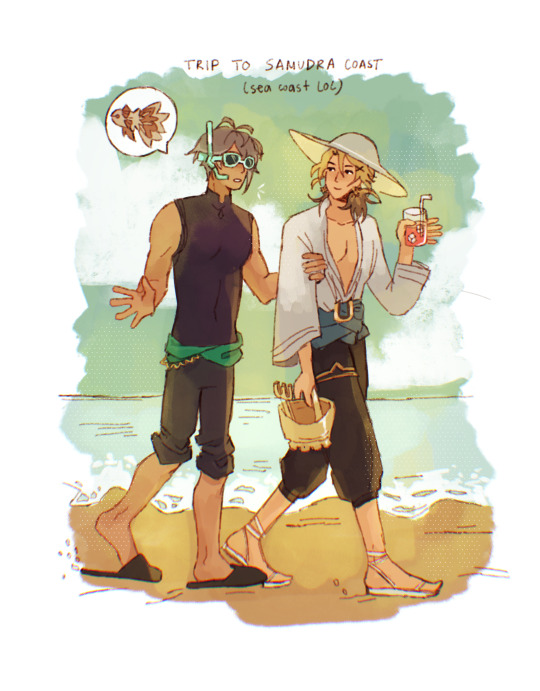


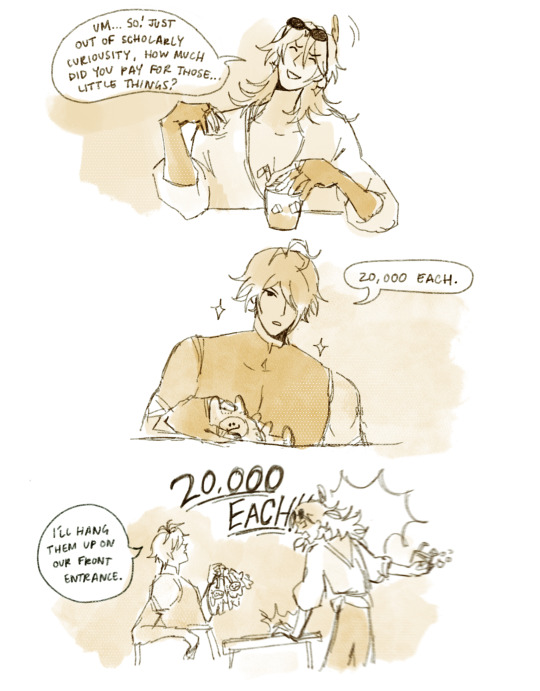
alhaitham and his army of aranabubus
3K notes
·
View notes
Text
I will NEVER see a prehistoric dinosaur
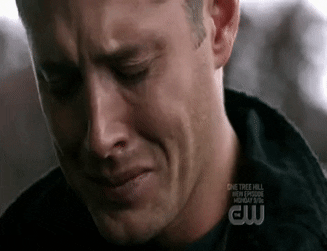
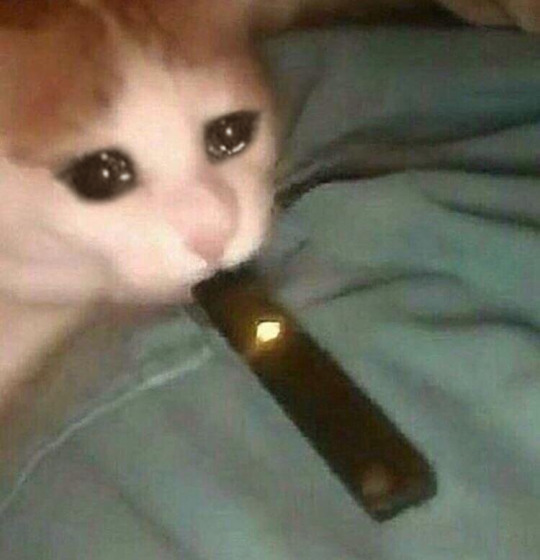
#every day I wake up and remember that extinct species are dead and I'll never be able to see them irl#:(
154K notes
·
View notes
Text
Happy Pride Month Everyone!! 🏳️🌈🏳️⚧️

I actually made this bunch of pride dinos last year, but I realised I never posted the finished version here, so here it is!!
I actually tried to incorporate some of the known coloration into the design if I could, which turned out to make for very interesting results, as you will see below:
Pride Flag: Caihong juji 🏳️🌈
The dinosaur that actually gave me the idea to incorporate the known colorations into the design. This dinosaur had iridescent feathers on its neck and chest of a variety of colours, so it probably had a sort of rainbow-like color scheme on those feathers (probably not that much like this one I depicted but similar), perfect for its flag!

Bisexual Flag: Microraptor gui 💗💜💙
Now for my personal favourite (partially not biased), and one of the ones that most closely resemble its actual irl coloration. The fossils preserve a full body, iridescent black coloration, similarly to crows. Normally these iridescent tones are blue, but they can range from purplish to even sort of magenta tones, which when combined correctly resembles its flag very well.

Lesbian Flag: Sinosauropteryx prima ❤️🧡🤍💗
Now for my second favourite and maybe the one that most closely resembles its flag irl. The fossil actually preserves red and orange tones with a white underbelly, and is also stripped like the flag! Pretty much the only thing I came up with was the magenta skin, which could very much be possible based on birds.
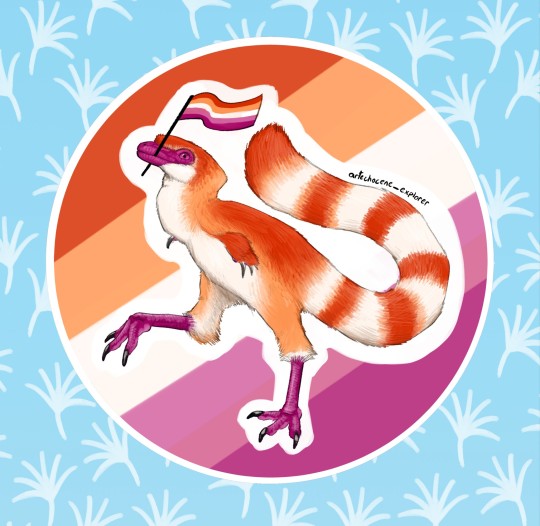
Trans Flag: Archaeopteryx lithograpica 🏳️⚧️
Now we start on the ones I had to stretch a bit to fit lol. For Archaeopteryx we only have ONE (1) black feather which we aren't sure of the position of, but it's probably from the wing, and given it was a coastal "bird", I gave it a seabird-like coloration. And the blue tuffs of feathers? Just some extra pizzazz to make it fit the flag.

Non-binary Flag: Jinfengopteryx elegans 🖤🤍💜💛
This one is closer than the previous one, as we know it had a spotted pattern on some points of the body, and probably some sort of lighter coloration on the tail feathers, so I went with yellow to, again, fit the flag.

Gay Men Flag: Confuciusornis sanctus 💚🤍💙
And again another vague one (can you tell I'm running out of things to say). We do know confuciusornis had some dark grey coloration around the chest and maybe some iridescence based on relatives, so it was good enough to fit this flag.

Pansexual Flag: Kulindadromeus zabaikalicus💖💛🩵
A really cool dinosaur (and I think the only one that is featured on an irl flag??) that preserves some stripped coloration on its leg filamentous feathers, which I combined with blue for the naked tail and legs of the animal to fit the flag colours.
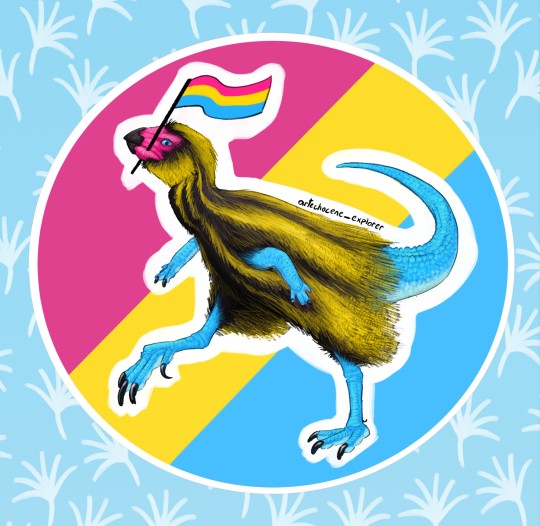
Asexual Flag: Caudipteryx zoui 🖤🤍💜
Another one with only patterns preserved, this one is actually pretty cool, as it preserves a stripped pattern on a small fan-like tail that it probably used for display. Thanks to the asexual community for making their flag these colours so it fit very well with a lot of dinosaurs 🫶🏻

Intersex Flag: Yi qi 💛🟣
Okay, sorry to disappoint but this one doesn't actually have any evidence of coloration, BUT the one thing that's preserved about this one's really cool! Instead of feathers, it uses a leathery membrane to glide in between trees, like a dinosaur version of a flying squirrel.
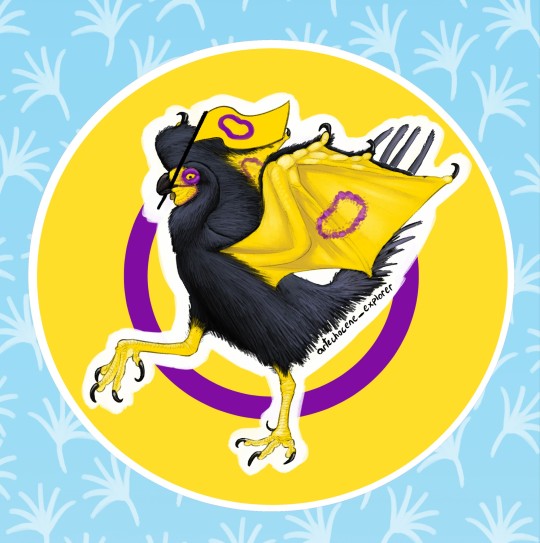
Anyways, I hope you enjoyed it and I'll try to post something that is not recycled from last year before June ends :>
#art#illustration#clip studio paint#paleoart#feathered dinosaurs#dinosaur#happy pride 🌈#pride#pride month
139 notes
·
View notes
Text
The Paradisaea Muse

Helloo it's my birthday! I usually don't draw humans at all but I feel like this was the perfect moment to draw my beautiful gorgeous wife Kaveh :>
Anyways I hope you all enjoy it despite being so different from my usual stuff uvu
24 notes
·
View notes
Text




Assorted sketches of the ryerunner, an ostrich-sized herbivore that lives on the wheat-covered planet Alicanto. Its frilled eyestalks fold over its head, forming a sort of natural balaclava that shields its eyes and upper nostrils in the strong winds. When extended, the underside is a bright, iridescent white; the sudden flash of a ryerunner's frill can be disorientating to practically anything with eyes in the dull sepia landscape.
Though they, as obligate herbivores, have little interest in eating other animals, ryerunners engage in a particularly gruesome form of kleptoparasitism: using their long front claw, they will cleanly "dissect" other plant-eating animals for their stomach contents (and another other occasional treats, such as gestating eggs or large internal parasites). By seeking out this partially digested food, they are able to add significant variation to their diet and include vegetation they would otherwise not be able to access. Attacks on carnivores are rarer, though still not especially uncommon. Herds of ryerunner will sometimes curiously follow animals, nutritional value or no, for up to several hours - both at ground level and by climbing to the surface of the wheat to stalk from above - before killing and carefully "dismantling" said animal as a group, a play behavior that reinforces social bonds and strengthens valuable hunting skills.
4K notes
·
View notes
Text

A pair of Giant Shaixuans having a snack near the shores of southern Samsara.
Warm summer waters provide breeding ground for burrowing heleophytes that shaixuans love to hunt along with plethera of many other animals hiding in the sand. A small alavir sea serpent follows the two to snack on small fish trying to hide in the shadows provided by the giants.

Shaixuans or sandmowers
Massive aquatic aliens that inhabit shallows of the southern shore, feeding on burrowing plants and animals hiding in the sand
They use their massive jaw that is locked in place to skim through the sand, devouring everything in their way. They live in small herds containing few mating pairs caring for their young, they are mouth brooders, using their small mandibles to shut their massive mouths to hide their young when needed
231 notes
·
View notes
Note
Have you heard that apparently the dinosaurs didn't die out from the meteor impact, but rather from a form of continuous volcanic eruption from the deccan traps?
Do you know if there's any merit to this theory?
that theory has been largely discounted because the Deccan Traps erupted around a million years before the meteor hit, and yet we see no decrease in fossil diversity in this period like we would expect if this caused the great extinction. Chicxulub is still the reigning champ of abrupt end-times, I'm afraid.
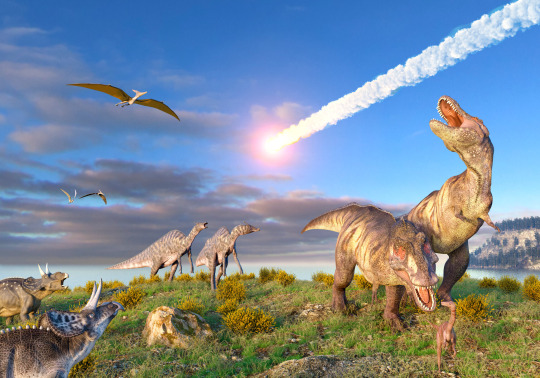
but this is probably because, unlike the Siberian Traps that accelerated the end-Permian Great Dying, the Deccan Traps were relatively slow! they did release absolutely staggering amounts of magma, but spread out over a period of like 800,000 years or so. life more or less just went on around it, presumably dodging the enormous surface pools of lava and plumes of toxic gas.
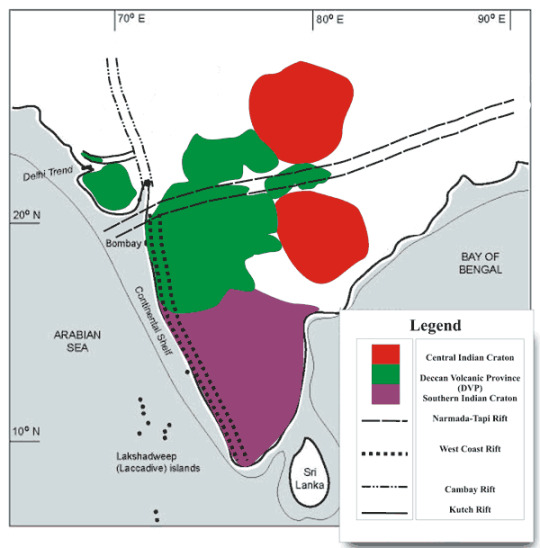
however there is a significantly more terrifying theory out there now that suggests that the Deccan Traps DID play into the end-cretaceous extinction event.... because the Chicxulub Impactor rattled the entire planet so hard that it caused almost every volcano on earth to erupt at the same time, including the Traps.

so yeah! fuck!
sleep well.
4K notes
·
View notes
Text

endlessly fascinated by kaveh’s hair
1K notes
·
View notes
Text

I lost 2 dollars to a slot machine at a casino 😔
So I drew Aventurine
3K notes
·
View notes
Text
Dungeon Meshi Encyclopaedia: The Minotaur
Another piece for the dungeon Meshi Encyclopaedia, a bit more simple while I work on the living armor, a bipedal and (literally) beefy creature: The Minotaur (Dipodotaurus bucephalus)

Full piece view
Close-ups and notes on the design choices:
The scientific name is, like a lot of the names I've been giving these creatures, not very complicated. The genus name refers to its bipedal (Dipodo- meaning bipedal in Latin) and bull features (-taurus meaning bull in Latin); and the specific name emphasizes its most prominent bull-like feature, its head, with bucephalus literally meaning ox-headed.
Although its more ruminant-like features superficially resemble cattle, they have a few differences, like having two rows of incisor teeth, unlike actual cattle which only have the bottom row of incisors. The human-like parts aren't fully based on humans either, as the abdominal muscles are much more divided, as they ancestrally evolved from a much longer torso, and also it's much more "bloated" than in humans, as it is based on actually herbivorous large apes, gorillas.


Close-up showing a male and a calf
The five fingered hands suggested to me this is not a normal ungulate, but some sort of veeeeery early ungulate (Phenacodus was used for skeletal reference) that convergently evolved some artiodactyl characteristics. I noticed a weird detail when looking for canon references, unlike cows and a lot of other artiodactyls, they don't seem to have hooves or even nails on the smaller fingers, which leads me to think it's maybe a hint of arboreal ancestry, and those were used to grip branches.
As for their social structure, I didn't have much to work with, as they barely explore it in the series, they only mention mothers have a strong bond with the calf and you need to look like one if you want to milk one. So I used that and the fact only females are seen in groups being calm is that they have a social structure similar to elephants, and bulls roam around alone looking for herds of tightly bound females with their calves.
About females, they seem to be quite different from males, having smaller horns and of course udders for lactating. It's not confirmed there's any size difference between males and females, but given their probable social structure I can guess they do
Surprisingly, it was hard to find any variations in minotaur coloration or anatomy in general like you see in cattle, with only a couple being shown, I imagine though that this is only due to them not being explored a lot in the series, but I assume they have as much variation as regular cattle, which I would love to see if they decide to explore it a bit in the anime.


Close-up of a female and a few variations in minotaur phenotypes
Anyways I hope you like this sort of treat before the proper big cool piece about the living armor, enjoy!! :>
#art#illustration#clip studio paint#speculative evolution#speculative biology#fanart#creature design#minotaur#dungeon meshi encyclopaedia#dungeon meshi#delicious in dungeon#mythology and folklore
88 notes
·
View notes
Text
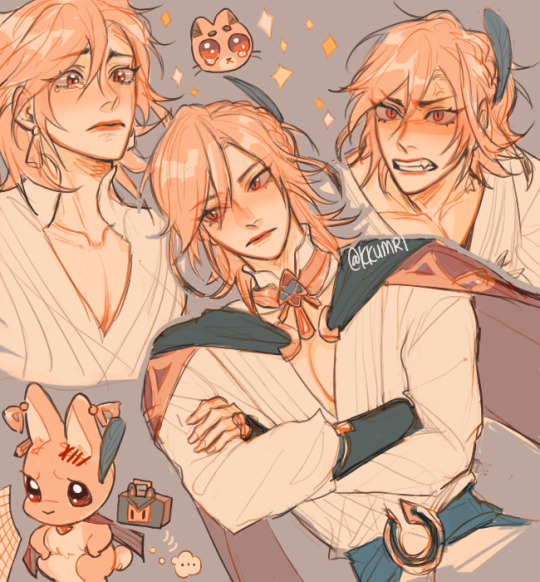
bunbun doodle 🐰🪶
4K notes
·
View notes
Text



I’ve been wanting to do a detailed tilted Antarctica map for a while now, but the low resolution of the bedmaps up until now and the need to reconstruct pre-glaciation topography made me a bit apprehensive to start it. However, the recent release of bedmap3 to the public gave me the motivation to give it a shot. For this map I used the isostatic adjustment from Paxman et al. (2022) on bedmap3 to create a version accounting for isostatic rebound. I then used the rasters of Antarctica during the Eocene-Oligocene boundary from reconstructions made by Paxman et al. (2019) and tried my best to combine it with my rebounded bedmap3 map, in order to preserve the fidelity of the highlands and add the features which were lost to erosion. I took this heightmap and ran it through Wilbur to carve out valleys and rivers as well as to add more detail to the coasts and ease the transition between the two maps. I then used the topography and likely climate of the continent to create a false satellite map. Finally, I looked up the names for various features, both glacial and subglacial to fill out the map. I also used qgis to help convert between projections and do raster calculations for the rebounded map.
Description:
It’s difficult to picture Antarctica as anything else aside from the vast frozen expanse we see at the bottom of the world today, but as with everything involving deep time, our present is only a snapshot in Earth’s history. Up until the Late Eocene, Antarctica was as rich and varied as any other landmass. From what little we have of Antarctica’s fossil record, its makeup was broadly similar to Pre-interchange South America, home to early Ungulates and Marsupials as well as their close relatives. Antarctica’s habitats were equally diverse, hosting grasslands and even Austral forests, likely resembling the Valdivian rainforests of Southern Chile, with even palms being present during the Paleogene. However, as South America and Australia departed northwards, the circumpolar-Antarctic current took hold, restricting the flow of warm subtropical waters to the poles. This cooled the continent and its elevated interior allowed glaciers to easily take hold, thereby dooming nearly all of its inhabitants to extinction.
But what if this wasn’t its fate? Let's imagine that over the course of the last 40-45 million years, Earth’s poles slowly change their positions, slowly enough that its disruption to Earth’s climate is about as gradual as the movement of the continents. By the present, the North Pole is over Africa, somewhere in Northeast Nigeria, and the south pole over the middle of the Pacific, adjacent to the Manihiki islands, which places Antarctica squarely in the Tropics with the new equator running through East Antarctica. The tilt chosen for this map is the same as Jaredia from the World Dream Bank’s Planetocopia, an old website which depicted alternate versions of Earth, as well as alien planets. For now, we won’t focus on the ramifications this has for the rest of the planet.
Being covered in glaciers over the last 34 million years has dramatically altered Antarctica’s topography, not only has the land been isostatically depressed, but the movement of glaciers has eroded vast tracts of the continent. This version of Antarctica never underwent any kind of extensive glaciation, resulting in a landmass quite alien compared to the one we would get if we simply removed the glaciers from Antarctica now. The Northeast of Antarctica is now covered in tropical rainforests, likely filled with a diverse array of marsupials and birds. Things become slightly drier as we travel inland and increase in elevation. Even without glaciers, much of the interior ranges from 1000-1300 meters above sea level, comparable to the South African Plateau; which now supports the world’s largest subtropical highlands, similar climatically to the highlands in Ethiopia. Much of the North-Eastern side of the highlands drains into the Lambert graben, a permian-aged rift, which now forms a bay. Rivers coming down from the highlands introduce an immense amount of water into the bay, making the majority of the bay range from fresh to brackish, and with the sediment supplied by the mountains making this bay rather shallow. During Glacial maximums, this bay transforms into a low-lying plain, the sediment of which now makes the seabed ample territory for seagrass meadows. Further into the highlands, we find Lake Vostok, now relieved of its burden of ice. Without the depression from the ice above, the coasts of lake Vostok sit at about 1000 meters above sea level and are surrounded by subtropical forests. The lake’s depths nearly extend back down to sea level, supporting hydrothermal vents like those in Lake Baikal, with the only indication that something is different being the new flow of detritus from above.
To the West we find a desert encompassing almost all of Marie Byrd Land and the Southern portion of the Palmer Peninsula. Sediment derived from the Marie Byrd land volcanic field, dispersed by the winds, colors vast swaths of the desert red. A few of the shield volcanoes in the Marie Byrd Land volcanic province rise high enough to capture some moisture, creating small oases of highland grasslands and in rare cases cloud forests. The Northern tropical forests of the Palmer peninsula are uniquely isolated from the mainland by Ronne bay to the East and the West Antarctic desert to the south, meaning any fauna here would likely be endemic to it. In the Ross Bay, the Transantarctic mountains cast a sizable rain shadow to the west, helping to form a narrow desert on the leeward side. In Ross bay, we also find a small archipelago of desert islands, with the largest being Penwell Island, a remnant of which exists in our Antarctica as Penwell Bank. To the South we reach the boundary between the tropics and subtropics. Near Antarctica’s new southernmost point we find the mouth of the Wilke’s river: the longest river on the Antarctic continent and which terminates with a wave-dominated delta. It’s also here that we find the largest permanent glacier on the continent, limited only to the highest points of the Victory Mountains.
Even without the circumpolar Antarctic current, Antarctica remains an extremely isolated landmass. No land bridges have connected it to any other continent since the Eocene, though South America (Now north of North America) remains just within reach. Ocean currents in the Drake Passage travel primarily from East to west, meaning that rafting events are unlikely to take settlers from South America to Australia, but could take settlers the other way around. It’s possible that South America could receive a regular influx of marsupials and other fauna from Antarctica over the course of millions of years.
Resources Used:
Bedmap3: https://data.bas.ac.uk/full-record.php?id=GB/NERC/BAS/PDC/01615
Reconstructions of Antarctic topography since the Eocene–Oligocene boundary: https://doi.org/10.1016/j.palaeo.2019.109346
Total isostatic response to the complete unloading of the Greenland and Antarctic Ice Sheets: https://www.nature.com/articles/s41598-022-15440-y
47 notes
·
View notes
Text
Dungeon Meshi Encyclopaedia: The Red Dragon
Another creature added to the dungeon meshi encyclopaedia!! Feared by every soul that enters the dungeon, this crimson titan can take down every creature that crosses its path: the Red Dragon (Ignidraco puniceus).

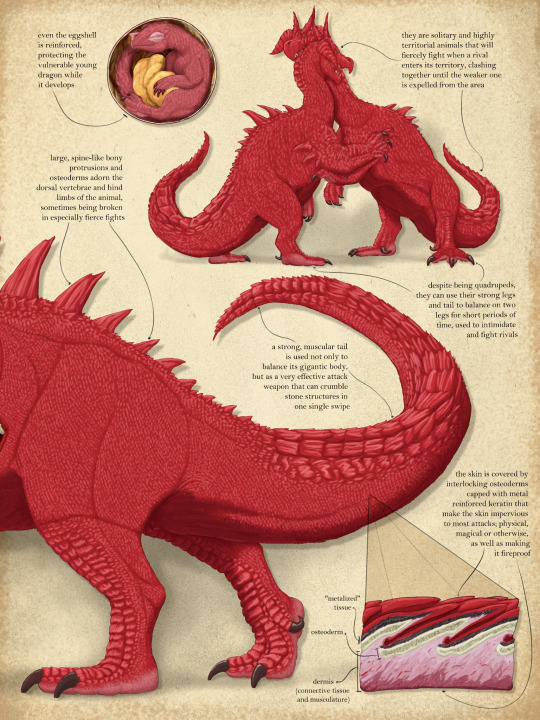
Full piece view
Close-ups and notes on the design choices:
The scientific name, like the last creature I drew, is pretty simple, as for the genus name is just a combination of fire (Igni-) and dragon (-draco); and the species name is a reference to its color, as "puniceus" refers to a bright red color (I also considered "sanguineus" for its blood red color).
This time for the external appearance of parts of the anatomy like osteoderm plates and general head morphology I stuck really close to the original design (although the body and specially head proportions are WILDLY inconsistent between manga and anime, and between parts of the same manga or anime sequence) so I tried to mix them all into a shape I ended up liking quite a lot. I based the "beak" and upper jaw texture on crocodilians and birds, and used ungulate horns as a reference for the keratin cover and the bony core shown in the skull illustration.
One detail I added that I felt was quite necessary are the black, iron covered osteoderms covering the tongue and inside of the mouth, that are used to create sparks and protect the mouth tissues from the heat. These are not present in the original design, the tongue and mouth are pink and smooth, but it probably wouldn't be able to create sparks by doing the tonguing motion without some sort of hard structure to smash together.
The inverse scale was one thing I initially wasn't sure how I was going to explain, until I started designing the mechanism of the gas fuel production in the stomach, and created this symmetrical gular sacs to hold the fuel before ignition, and thought that maybe the development of those sacs could've pushed the aorta artery to pass through the middle of the neck, right below that scaleless spot. This would definitely be a very vulnerable spot and cause the results we see in the series if that point is stabbed, with blood gushing out at high pressures and causing the dragon to rapidly bleed out.

Close-up of the head, fire breath and neck internal structure
My favourite part of the design process for this one was making the fuel mechanism. I love that the indigestible materials, similarly to birds like owls, are accumulated in the anterior chamber of the stomach and used to create fuel (this part is exclusive to dragons owls unfortunately don't produce fire from their pellets). Because the way they ignite the fuel is ambiguous, and it would be hard for the dragon to straight up ignite a stream of wet hair and bones, I opted for giving it a symbiotic relationship with microbes, hydrogen producing ones to be exact (which do exist btw). These microbes could adapt to the acidic environment of the stomach chambers, not competing with other microbes, which would allow them to produce more hydrogen. Which if you don't know, it's not only light, but extremely flammable. I would imagine at first the gular gas chambers evolved, and then the separate had tubes evolved for a more effective transport of the gas towards the sacs.

Close-up of the proventriculus, interior of the "dragon pellet" and front legs
For the second cutout I chose the "stomach" they mention in the series, which is technically not the whole stomach but a chamber of it, the gizzard, which is also found in birds and non-avian dinosaurs. I would imagine not all indigestible materials can be dissolved by the stomach acid, or digested by microbes to create fuel, but I feel like the dragon can use those as gizzard stones, to grind up the food it probably swallows whole (given that the "dragon pellet" had bones, hair and human tools). The heat and constant grinding would eventually smooth the material into round-ish objects that would eventually be passed through after being too worn down.

Close-up of the gizzard and lungs of the dragon
The skin was another part I had to speculate a little, and sort of used the ol' reliable, iron mineralised tissue, but not quite. I imagine it probably incorporates iron oxides into the keratin (maybe that's why it's red??), but below it, above the osteoderm, there is a layer of not only iron mineralised tissue, but also mixed with other more durable metals (maybe adamant?) to make it more resistant to physical and magical attacks.

Close-up of the tail and a tissue cutout of the skin showing all layers up to the dermis
The best way to fill an empty space where I don't know what to put in these pieces, babies! In this case, a baby dragon inside of a very spherical egg, similar to the ones other giant reptiles laid, such as sauropods. I would also imagine female dragons demineralise some of the iron in their tissues to reinforce the egg, making it less susceptible to braking. Also like most reptiles (including extinct ones like sauropods) it has an egg tooth that falls off after hatching.

Close-up of the back spines and a dragon egg, showing a developing embryo inside
Lastly, I had to include something about their social behaviour, so I included a drawing that is very similar to a sketch made by Ryoko Kui herself, showing the different intraspecific social behaviour of different dragon types, with red dragons being described as "persistent" and that "the weaker one will be forced to leave first". So I imagine they fight similarly to komodo dragons (since they're also shown to be able to stand on two legs for short periods of time). They probably also don't fight a lot, prefering to show off and intimidating the rival without wasting their precious fire, but using their other weapon arsenal to fight the other if they have to.

Close-up of a couple of female dragons fighting
Anyways this was all, I spent a LONG time on this one as you can see so I hope you enjoy it, the living armor is next!! :>
#art#my art#dungeon meshi encyclopaedia#illustration#clip studio paint#speculative evolution#speculative biology#fanart#creature design#spec evo#delicious in dungeon#dragon#red dragon
181 notes
·
View notes
Text

Some lil baby ammonites I made the other day because I was out of creative juices
Inspired by these cute little guys from Prehistoric Planet S2:

186 notes
·
View notes